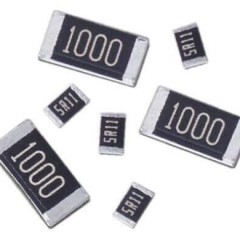Online calculation of the resistor for the LED
Powering LEDs is not such a simple question as it might seem. They are extremely sensitive to the mode in which they work and do not tolerate overloads. The most important thing to remember is that semiconductor emitting diodes supply a stable current, not voltage. Even a perfectly stabilized voltage will not provide support for a given mode, this is a consequence of the internal structure and principle of operation of semiconductors. Nevertheless, with a competent approach, LEDs can be connected to power through a current-limiting or additional resistor. His calculation is reduced to an elementary selection of such a resistance, on which excess Volts will fall at a given current value. Let's look at how to calculate its face value manually or use an online calculator.
Although the main parameter for powering the LED is current, there is also such as a voltage drop. This value is necessary for it to light up. Based on it, a limiting resistor is calculated.
Typical LED voltages of different types:
| Colour | Voltage |
| White | 2.8-3.2 for low-power, 3.0 and higher for powerful (more than 0.5 W) |
| Red | 1.6-2.0 |
| Green | 1.9-4.0 |
| Blue | 2.8-3.2 |
| Yellow orange | 2.0-2.2 |
| IR | Up to 1.9 |
| UV | 3.1-4.4 |
Attention! If you cannot find the documentation for an existing item - when using the online calculator, take the data from this table.
To reduce the theory, let's immediately in practice calculate the resistance for connecting a white LED to the on-board circuit of a 12V car. Its actual value with the engine running reaches 14.2 V, and sometimes even higher, which means we take it for calculations.
Then the calculation of the resistance for the LED is performed by Ohm's law:
R = U / I
On the LED, an average of 3 Volts should fall, so you need to compensate:
Ures = 14.2-3 = 11.2 V
A typical 5 mm LED has a nominal current of 20 mA or 0.02 A. We calculate the resistance of the resistor, on which 11.2 V should fall at a given current:
R = 11.2 / 0.02 = 560 Ohms or the closest up
In order to achieve stable power supply and brightness, an L7805 or L7812 stabilizer is additionally installed in the power circuit and the calculation is carried out relative to the power supply 5 or 12 Volts, respectively.
How to calculate a resistor for connecting an LED to a 220 volt network? Such a question arises when you need to make some kind of indication or a beacon. The calculation of resistance in this case looks like this:
Urez = 220-3 = 217 V
R = 217 / 0.02 = 10850 Ohms
Since any diode passes current in one direction, the reverse voltage will lead to the fact that it will fail. So, parallel to the LED, they install another same or shunting ordinary low-power rectifier diode, for example, 1n4007.
Using our online calculator, you can calculate the resistance for one or several parallel LEDs connected in series or circuit:
If there are several LEDs, then:
- For a series connection, the resistor is calculated taking into account the sum of the drops on each element.
- For parallel connection, the resistance is calculated taking into account the sum of the currents of each light emitting diode.
Also, one should not forget about the power of the resistor, for example, in the second example with a circuit connected to a 220V network, a power equal to will be allocated on it:
P = 217 * 0.02 = 4.34 watts
In this case, it will be a rather large resistor. To reduce this power, you can further limit the current, for example, to 0.01A, which will reduce this power by two. In any case, the rated power of resistance should be greater than that which will be released during its operation.
For a long and stable operation of the emitter when connected to the network, use the voltage slightly higher than the rated voltage, i.e. 230-240 V.
If it is difficult for you to calculate or you are not sure about something, then our online calculator for calculating the resistor for the LED will quickly tell you which resistor from the standard size range, as well as its minimum power, is needed.







Your calculator does not work for 3 watt LEDs, the current of these diodes according to the passport is 700 mA